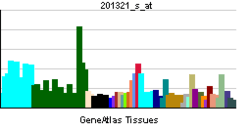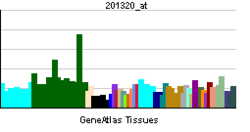SMARCC2
SWI/SNF complex subunit SMARCC2 is a protein that in humans is encoded by the SMARCC2 gene.[1][2][3]
Function
The protein encoded by this gene is a member of the SWI/SNF family of proteins, whose members display helicase and ATPase activities and which are thought to regulate transcription of certain genes by altering the chromatin structure around those genes. The encoded protein is part of the large ATP-dependent chromatin remodeling complex SNF/SWI and contains a predicted leucine zipper motif typical of many transcription factors. Two transcript variants encoding different isoforms have been found for this gene.[3]
Interactions
SMARCC2 has been shown to interact with BAZ1B[4] and SMARCA4.[5][6][7]
References
- ↑ Wang W, Xue Y, Zhou S, Kuo A, Cairns BR, Crabtree GR (November 1996). "Diversity and specialization of mammalian SWI/SNF complexes". Genes Dev 10 (17): 2117–30. doi:10.1101/gad.10.17.2117. PMID 8804307.
- ↑ Ring HZ, Vameghi-Meyers V, Wang W, Crabtree GR, Francke U (September 1998). "Five SWI/SNF-related, matrix-associated, actin-dependent regulator of chromatin (SMARC) genes are dispersed in the human genome". Genomics 51 (1): 140–3. doi:10.1006/geno.1998.5343. PMID 9693044.
- ↑ 3.0 3.1 "Entrez Gene: SMARCC2 SWI/SNF related, matrix associated, actin dependent regulator of chromatin, subfamily c, member 2".
- ↑ Kitagawa H, Fujiki R, Yoshimura K, Mezaki Y, Uematsu Y, Matsui D et al. (June 2003). "The chromatin-remodeling complex WINAC targets a nuclear receptor to promoters and is impaired in Williams syndrome". Cell 113 (7): 905–17. doi:10.1016/S0092-8674(03)00436-7. PMID 12837248.
- ↑ Wang W, Côté J, Xue Y, Zhou S, Khavari PA, Biggar SR et al. (October 1996). "Purification and biochemical heterogeneity of the mammalian SWI-SNF complex". EMBO J. 15 (19): 5370–82. PMC 452280. PMID 8895581. Vancouver style error (help)
- ↑ Otsuki T, Furukawa Y, Ikeda K, Endo H, Yamashita T, Shinohara A et al. (November 2001). "Fanconi anemia protein, FANCA, associates with BRG1, a component of the human SWI/SNF complex". Hum. Mol. Genet. (England) 10 (23): 2651–60. doi:10.1093/hmg/10.23.2651. ISSN 0964-6906. PMID 11726552.
- ↑ Zhao K, Wang W, Rando OJ, Xue Y, Swiderek K, Kuo A et al. (November 1998). "Rapid and phosphoinositol-dependent binding of the SWI/SNF-like BAF complex to chromatin after T lymphocyte receptor signaling". Cell 95 (5): 625–36. doi:10.1016/S0092-8674(00)81633-5. PMID 9845365.
Further reading
- Wang W, Côté J, Xue Y, Zhou S, Khavari PA, Biggar SR et al. (1996). "Purification and biochemical heterogeneity of the mammalian SWI-SNF complex". EMBO J. 15 (19): 5370–82. PMC 452280. PMID 8895581. Vancouver style error (help)
- Wang W, Chi T, Xue Y, Zhou S, Kuo A, Crabtree GR (1998). "Architectural DNA binding by a high-mobility-group/kinesin-like subunit in mammalian SWI/SNF-related complexes". Proc. Natl. Acad. Sci. U.S.A. 95 (2): 492–8. doi:10.1073/pnas.95.2.492. PMC 18447. PMID 9435219.
- Cho H, Orphanides G, Sun X, Yang XJ, Ogryzko V, Lees E et al. (1998). "A Human RNA Polymerase II Complex Containing Factors That Modify Chromatin Structure". Mol. Cell. Biol. 18 (9): 5355–63. PMC 109120. PMID 9710619.
- Phelan ML, Sif S, Narlikar GJ, Kingston RE (1999). "Reconstitution of a core chromatin remodeling complex from SWI/SNF subunits". Mol. Cell 3 (2): 247–53. doi:10.1016/S1097-2765(00)80315-9. PMID 10078207.
- Bochar DA, Wang L, Beniya H, Kinev A, Xue Y, Lane WS et al. (2000). "BRCA1 is associated with a human SWI/SNF-related complex: linking chromatin remodeling to breast cancer". Cell 102 (2): 257–65. doi:10.1016/S0092-8674(00)00030-1. PMID 10943845.
- Kadam S, McAlpine GS, Phelan ML, Kingston RE, Jones KA, Emerson BM (2000). "Functional selectivity of recombinant mammalian SWI/SNF subunits". Genes Dev. 14 (19): 2441–51. doi:10.1101/gad.828000. PMC 316972. PMID 11018012.
- Xue Y, Canman JC, Lee CS, Nie Z, Yang D, Moreno GT et al. (2001). "The human SWI/SNF-B chromatin-remodeling complex is related to yeast Rsc and localizes at kinetochores of mitotic chromosomes". Proc. Natl. Acad. Sci. U.S.A. 97 (24): 13015–20. doi:10.1073/pnas.240208597. PMC 27170. PMID 11078522.
- Sif S, Saurin AJ, Imbalzano AN, Kingston RE (2001). "Purification and characterization of mSin3A-containing Brg1 and hBrm chromatin remodeling complexes". Genes Dev. 15 (5): 603–18. doi:10.1101/gad.872801. PMC 312641. PMID 11238380.
- Kato H, Tjernberg A, Zhang W, Krutchinsky AN, An W, Takeuchi T et al. (2002). "SYT associates with human SNF/SWI complexes and the C-terminal region of its fusion partner SSX1 targets histones". J. Biol. Chem. 277 (7): 5498–505. doi:10.1074/jbc.M108702200. PMID 11734557.
- Battaglioli E, Andrés ME, Rose DW, Chenoweth JG, Rosenfeld MG, Anderson ME et al. (2002). "REST repression of neuronal genes requires components of the hSWI.SNF complex". J. Biol. Chem. 277 (43): 41038–45. doi:10.1074/jbc.M205691200. PMID 12192000. Vancouver style error (help)
- Olave I, Wang W, Xue Y, Kuo A, Crabtree GR (2002). "Identification of a polymorphic, neuron-specific chromatin remodeling complex". Genes Dev. 16 (19): 2509–17. doi:10.1101/gad.992102. PMC 187451. PMID 12368262.
- Nie Z, Yan Z, Chen EH, Sechi S, Ling C, Zhou S et al. (2003). "Novel SWI/SNF Chromatin-Remodeling Complexes Contain a Mixed-Lineage Leukemia Chromosomal Translocation Partner". Mol. Cell. Biol. 23 (8): 2942–52. doi:10.1128/MCB.23.8.2942-2952.2003. PMC 152562. PMID 12665591.
- Kitagawa H, Fujiki R, Yoshimura K, Mezaki Y, Uematsu Y, Matsui D et al. (2003). "The chromatin-remodeling complex WINAC targets a nuclear receptor to promoters and is impaired in Williams syndrome". Cell 113 (7): 905–17. doi:10.1016/S0092-8674(03)00436-7. PMID 12837248.
- Hsiao PW, Fryer CJ, Trotter KW, Wang W, Archer TK (2003). "BAF60a Mediates Critical Interactions between Nuclear Receptors and the BRG1 Chromatin-Remodeling Complex for Transactivation". Mol. Cell. Biol. 23 (17): 6210–20. doi:10.1128/MCB.23.17.6210-6220.2003. PMC 180928. PMID 12917342.
- Bouwmeester T, Bauch A, Ruffner H, Angrand PO, Bergamini G, Croughton K et al. (2004). "A physical and functional map of the human TNF-alpha/NF-kappa B signal transduction pathway". Nat. Cell Biol. 6 (2): 97–105. doi:10.1038/ncb1086. PMID 14743216.
- Kuwabara T, Hsieh J, Nakashima K, Taira K, Gage FH (2004). "A small modulatory dsRNA specifies the fate of adult neural stem cells". Cell 116 (6): 779–93. doi:10.1016/S0092-8674(04)00248-X. PMID 15035981.
- Beausoleil SA, Jedrychowski M, Schwartz D, Elias JE, Villén J, Li J et al. (2004). "Large-scale characterization of HeLa cell nuclear phosphoproteins". Proc. Natl. Acad. Sci. U.S.A. 101 (33): 12130–5. doi:10.1073/pnas.0404720101. PMC 514446. PMID 15302935. Vancouver style error (help)

